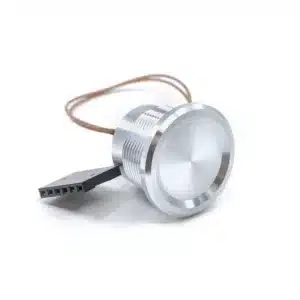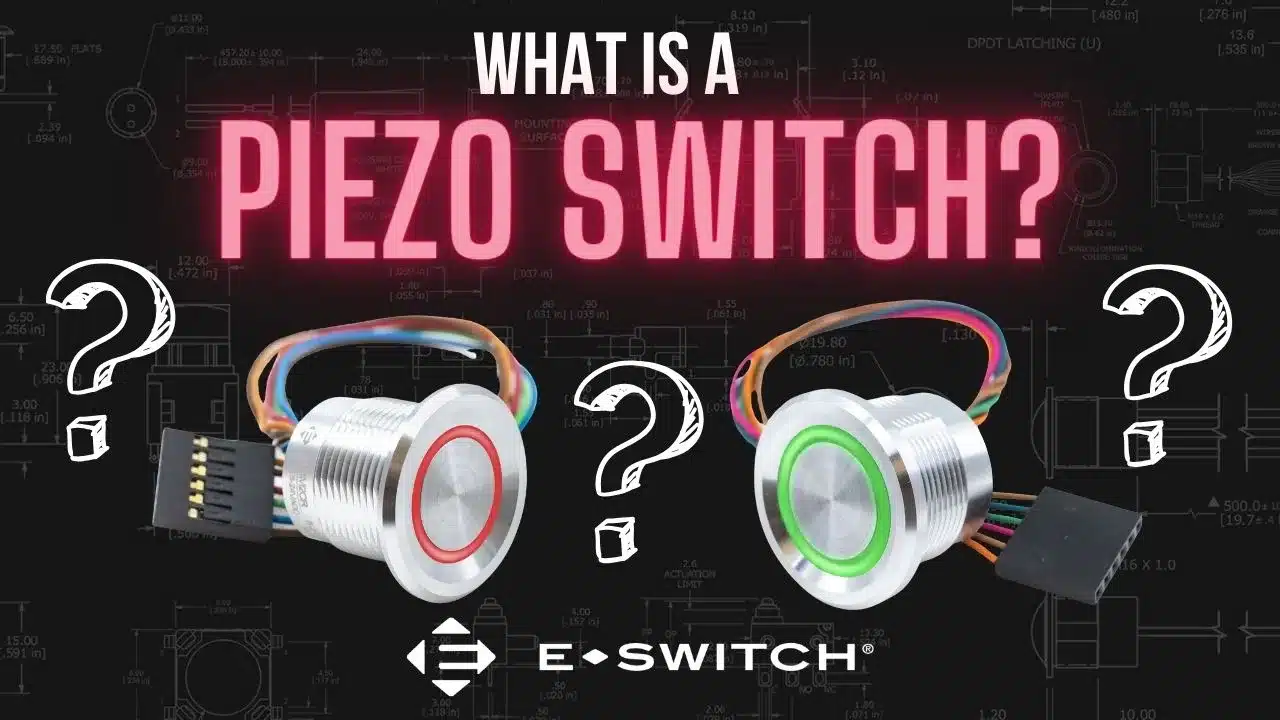What is a Piezo Switch?
A piezo switch, also known as a piezoelectric switch, is a type of switch that uses the piezoelectric effect to generate an electrical signal when mechanical pressure is applied to it. The piezoelectric effect is a phenomenon where certain materials generate an electric charge in response to applied mechanical stress or deformation. In the context of mechanical switches, the piezoelectric effect is utilized to convert mechanical pressure into an electrical signal. This provides a reliable and durable method for controlling various electronic devices and systems.
How do Piezo Switches Work?

In five steps, here’s how a piezo switch works:
#1. Piezoelectric Material — The switch contains a piezoelectric material, which is often a crystal or ceramic with piezoelectric properties. Common materials include quartz, lead zirconate titanate and certain types of ceramics.
#2. Deformation — When mechanical pressure or force is applied to the piezoelectric material, it undergoes deformation. This deformation causes the arrangement of atoms or molecules within the material to shift, creating an imbalance of positive and negative charges.
#3. Electric Charge Generation — As a result of this imbalance, an electric charge accumulates on the surfaces of the piezoelectric material. The amount of charge generated is directly proportional to the magnitude of the applied force.
#4. Detection and Signal Processing — The electric charge generated by the piezoelectric material is then detected by the conductive layers or electrodes connected to the switch. This detection of charge serves as the trigger for the switch to perform a specific action, such as closing or opening an electrical circuit.
#5. Release and Reset — When the mechanical pressure is released, the piezoelectric material returns to its original state and the electric charge dissipates. This allows the switch to reset and prepare for subsequent activations.
What are Piezo Switches Used for?
Industrial Controls: They’re often employed in industrial control panels and machinery where durability, resistance to harsh environments and precise actuation are critical.
Medical Devices: They’re used in medical devices and equipment where cleanliness, reliability and precise control are essential. They can be found in medical instruments, diagnostic equipment, surgical devices and patient monitoring systems.
Automotive Applications: They’re utilized in automotive applications where durability, resistance to environmental factors and space-saving designs are important. They can be found in car interiors for functions such as door locks, window controls, dashboard controls and steering wheel-mounted controls.
Consumer Electronics: They’re incorporated into various consumer electronics devices due to their compact size, low power consumption and resistance to wear and tear. They can be found in devices such as smartphones, tablets, remote controls, gaming controllers and wearables.
Aerospace and Defense: They’re used in aerospace and defense applications where reliability, durability and resistance to extreme conditions are crucial. They can be found in aircraft controls, cockpit instrumentation, military vehicles and ruggedized communication equipment.
Public and Commercial Spaces: Piezo switches are utilized in public and commercial spaces for applications such as elevator controls, access control systems, vending machines and public information kiosks.
Home Appliances: They can be found in home appliances such as ovens, microwaves, dishwashers and washing machines, where reliability and resistance to moisture and dirt are important considerations.
Pros & Cons
Pros
Durability: Piezo switches have no moving parts, reducing the risk of mechanical failure due to wear and tear. They are highly durable and can withstand millions of actuations without degradation.
Environmental Resistance: Piezo switches are resistant to environmental factors such as moisture, dust, vibration and temperature fluctuations. This makes them suitable for use in harsh or demanding environments where traditional switches may fail.
Sealed Design: The absence of moving parts allows piezo switches to be sealed, preventing contaminants from entering the switch mechanism. This makes them ideal for applications where cleanliness and hygiene are important, such as medical equipment and food processing machinery.
High Sensitivity: Piezo switches can detect even slight pressure changes, providing precise control and feedback. This high sensitivity makes them suitable for applications where precise actuation is required, such as touch-sensitive interfaces.
Low Power Consumption: Piezo switches typically require very little power to operate, making them energy-efficient and suitable for battery-powered devices.
Cons
Cost: Piezo switches can be more expensive to manufacture than traditional mechanical switches due to the specialized materials and manufacturing processes involved.
Limited Travel Distance: Piezo switches typically have a shorter travel distance and less tactile feedback compared to mechanical switches. This may result in a different user experience, particularly for users accustomed to the feel of traditional switches.
Complex Integration: Integrating piezo switches into electronic systems may require specialized knowledge and design considerations. This complexity can increase development time and cost.
Less Familiarity: Piezo switches are less common and less familiar to users compared to traditional mechanical switches. Users may require some time to adjust to the different feel and actuation mechanism of piezo switches.
Limited Actuation Force Range: Piezo switches may have limitations in the range of actuation forces they can reliably detect. This can affect their suitability for applications where a wide range of actuation forces is required.
E-Switch Piezo Switch Offerings
PZ Series Anti-Vandal, Illuminated Piezo Switch
The PZ Series is an anti-vandal, illuminated piezo switch with momentary pulse function and 50 million cycles of electrical life. This piezo switch is available in two sizes: PZ4 (19mm diameter panel cutout) and PZ7 (22mm diameter panel cutout). Both require 10mm maximum panel thickness. PZ Series anti-vandal piezo switches are offered as non-illuminated or ring pattern illumination with LED RGB. Options include black or clear anodized housing finish, concave or flat bezel option and standard wire lead termination with 150mm or 300mm length leads. The electrical rating on this illuminated piezo switch is 1A of 5-24VDC with a contact resistance of 1Ω maximum. This anti-vandal switch operates in temperatures ranging from -20⁰C to 65⁰C and can be stored at temperatures between -25⁰C to 65⁰C. The PZ Series anti-vandal, piezo switches are suitable for audio/visual equipment, electrical housewares, security devices, medical equipment, industrial controls and kiosks. Learn more here or by watching our E-Bits video below.
